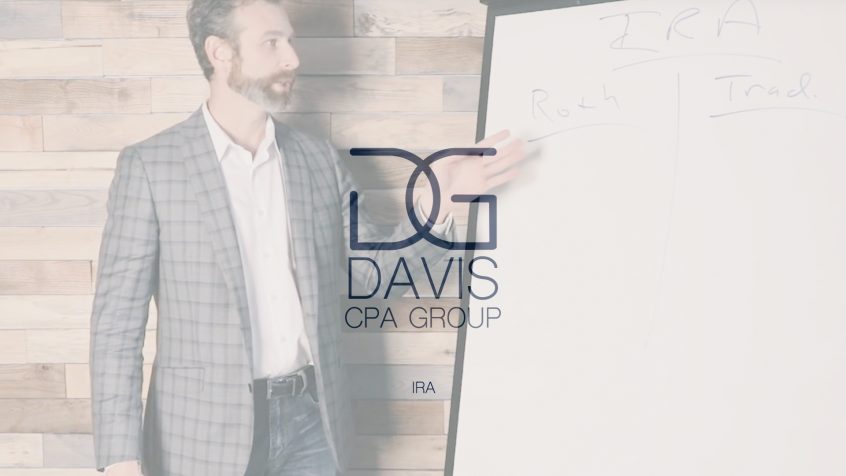Hi, Brandon Davis, with Davis CPA Group. Today we’re going to talk about Individual Retirement Accounts or IRAs. I get a lot of questions about different types of IRAs, what makes sense from the standpoint of what the, a Roth versus a traditional, so we’re gonna jump in and talk about that.
So when we talk about IRAs, again Individual Retirement Account or Individual Retirement Arrangements, that’s generally what that stands for, there’s two basic types of IRAs. You’ve got what they call Roth IRAs and you have traditional IRAs, so I’m just gonna say, just abbreviate that.
The main difference between the two is how they’re treated for tax purposes. A Roth IRA is an IRA that you can contribute funds to that is made with after tax dollars, meaning you’ve paid tax on those earnings, so say for example, you have a job, and you make $50,000 dollars a year and you wanna fund an IRA and so you’ll take your money that you’ve already paid tax on, that 50 thousand, put it into an IRA and then you don’t get a tax deduction for that. Basically, what happens is that money grows tax free, as in, so when you take it out at a later date, you pull out the money you put in, plus your earnings and there’s no income tax on that based on our current laws.
Traditional IRA is different. You get the tax deduction in the year that you make the contribution and so it’s made with pre-tax dollars so same fact powered in as before. You have $50,000 dollars in wages. You put five thousand dollars let’s say into a traditional IRA. You get to deduct that $5,000 on your personal tax return to reduce your taxable income in the year you make the contribution. Now that money grows tax deferred, not tax free. So as the money sits in the IRA account and accumulates earnings of either how it’s invested or what have you, when you pull that money out at retirement age, you basically have to pick that back up as income. And it would include the earnings at that point too. Whatever you pull out of that traditional IRA in the future is taxable income at ordinary income rates.
I’m not gonna get into the details too much of tax rates and things of that nature because I wanna kind of do a high level discussion on IRAs, but that’s where the planning really comes into play to figure out which one makes the most sense for you is figuring out one, what your tax rates are, what you think your tax rates are gonna be at retirement and kind of what your overall financial goals are.
Something else to point out too, there’s limitations on when you can contribute to a Roth versus a traditional IRA. So again, a Roth is done with pre-tax money and it grows tax free. So I wanna put that on here so you can make notes of that at home if you need to. Traditional is done with. I’m sorry this is post tax. And this is done with pre-tax dollars, so you get a tax deduction for it when you put the money in and it’s taxable when withdrawn, so at withdrawal. So that’s something to think about too.
Something else that I need to point out, there’s income limitations. So if your AGI is over certain levels, then you’re precluded from being able to contribute to a Roth IRA so that’s something you gotta think about. You have to have earned income to be able to contribute to either one of these and also, if you’re covered by another type of plan. Say you’re an employee somewhere and you participate ina 401 (k) plan or a simple IRA plan that they may offer, then that may preclude you from being able to contribute also. Once you hit certain income thresholds, if you participate in these types of arrangements, you can’t then participate in additional retirement plans.
There are, however, benefits where maybe your spouse could. So for example, say you work, and you make $50,000 dollars a year in wages, you participate in a company sponsored plan with your employer, like say for in this case, a 401 (k) plan, you contribute to that 401 (k) plan, while your wife doesn’t have earned income, but based on your income situation and such, she could then contribute to what’s called a spousal IRA or she could have her own IRA that she could contribute to and put some funds away also so that’s something, from a planning perspective, that you could look at doing.
So those are the main two differences between the two. Now I’ll talk through IRAs a little bit more. You know a couple other things that come up oftentimes is say, okay, I’m putting money into the IRA, and it’s stuck in there and it’s growing. And it’s stuck in there until you reach retirement age. Because if you pull funds out of an IRA, particularly a traditional IRA before you turn 59 and a half, that’s kind of the magical age that you can start drawing out of your IRA penalty free. If you contribute to an IRA and you remove the funds before you’re 59 and a half, you’re subject to an additional tax. It’s called a penalty. But it’s essentially an additional tax of 10% of whatever you draw and it’s called an early withdrawal penalty.
Like I said in previous videos, I don’t write very well and I don’t spell very well so that’s why I try to read to you what I put up here. But anyway, so 59 and a half, is kind of the magical age to be able to draw funds from an IRA penalty free. Now, again, in a traditional IRA setting, it’s still taxable income to you. The argument generally is such though, during your working years, while you’re putting money into an IRA, and getting a tax deduction, you’re at higher tax rates. And that when you hit retirement age, you’re only gonna draw out the minimum you need to live in, hopefully a lot of your debts are paid off, and you’re kind of in a situation where you don’t have a lot of outstanding cash flow needs and so you’re drawing out that money and lower tax rates.
Now there’s still a softball discussions on both sides aboard versus well maybe a Roth’s a way to go versus a traditional, that’s not for today. I’m just gonna walk you through some of the facts that you deal with in an IRA setting. So 59 and a half is the magical age where you can start drawing those things out penalty free. There’s another magical age we’ve gotta discuss too and that’s age 70 and half. At 70 and a half, so age 70.5, you have to start taking, or you’re forced to take distributions from your IRAs. These are called required minimum distributions, RMDs is what all people in my industry call those, and so once you reach 70 and a half, you have to start taking a percentage of your IRA out every year.
Well you may be asking, well what’s that percentage? Well, the answer is it kinda depends. Depends on a couple things. The first factor it depends on is we take the value of your IRAs, all of your IRAs at 12/31 of the previous year and so it’s, if you turn 70 and a half in 2018, the year that we’re in, we would then look at the fair market value of your IRA at 12/31/2017 and then we apply some factors, some actuarial factors that have been established by the IRS, and they get updated from time to time, but we take that factor, based on your age, times your fair market value of your accounts, meaning the value of dollars that’s in your accounts. So say maybe that’s a hundred thousand dollars is how much the value is at the end of 2017, and that tells you how much you’re required to take out each year.
As you age, that factor changes such that you’re required to take a little bit more every year, so the older you are, the more you’re required to take out as a percent of the value of your account. And this is basically forcing individuals then to recognize that as income. Where this kinda gets interesting and where this really comes into play, that kinda gets missed a lot is another scenario with IRAs, and that’s inheriting an IRA.
So a lot of my clients that inherit IRAs, are inheriting them from members of their family that are in this RMD status, meaning they’re 70 and a half, they pass away, and now the heirs are looking at inheriting this. Well, this is a planning opportunity and this is where you need to consult somebody, maybe to talk through what the best options are for you because if you inherit an IRA, so if it’s gonna be, if you inherit it and it’s in RMD status, meaning the person that passed away, the decedent was 70 and a half, then you got some options. You can take a 100% of that IRA value at the time of that person’s passing, distribute it all out, it would all be taxable income to you because it was taxable income to the decedent and you pay tax on that money.
Now maybe you need the money or maybe you have a situation where you don’t have a whole lot of other taxable income and maybe that makes sense. So option one is, upon inheritance, you withdraw 100%. I’m just gonna abbreviate, so withdraw 100% of the value of the IRA, it’s all gonna be taxable.
Or option two is, since it was in the RMD status, you’re allowed to continue the required minimum distributions, even though you’re not 70 and a half yet. You may be 45 years old. You inherit this IRA from your dad who is in RMD status, so now you’re required to take the RMDs at your tax rates, so you take 100% of it, penalty free, because again it’s an inherited IRA so there’s no penalty, and so you have 100% taxable income to you or you can continue to get the RMDs and let’s say this thing’s worth a hundred thousand dollars. Well if you do 100%, it’s hundred thousand dollars of additional income in the year that the decedent or your dad passed away that you had to pick up in income this year.
Or you take the RMDs that he was taking, this is probably a smarter move unless there’s a need for the funds or you have something you wanna do with that cash. If you take the, continue the required minimum distributions, then you’re only picking up into your tax rate, what you’re required, what you’re dad would have been required to take out.
There’s actually a third option. The third option is to continue the RMDs, but have them recalculated based on your life expectancy so you can recalculate and do that based on your life expectancy and so that brings the RMD down now and puts you in a little bit better shape so there’s some options, there’s some tax planning that really goes into play when you’re looking at inheriting IRAs and what that might look like so you certainly wanna consult your tax advisor whenever you’re looking either contributing to an IRA, which IRAs right for you, what can you contribute to based on your income levels, and what happens when someone passes away.


